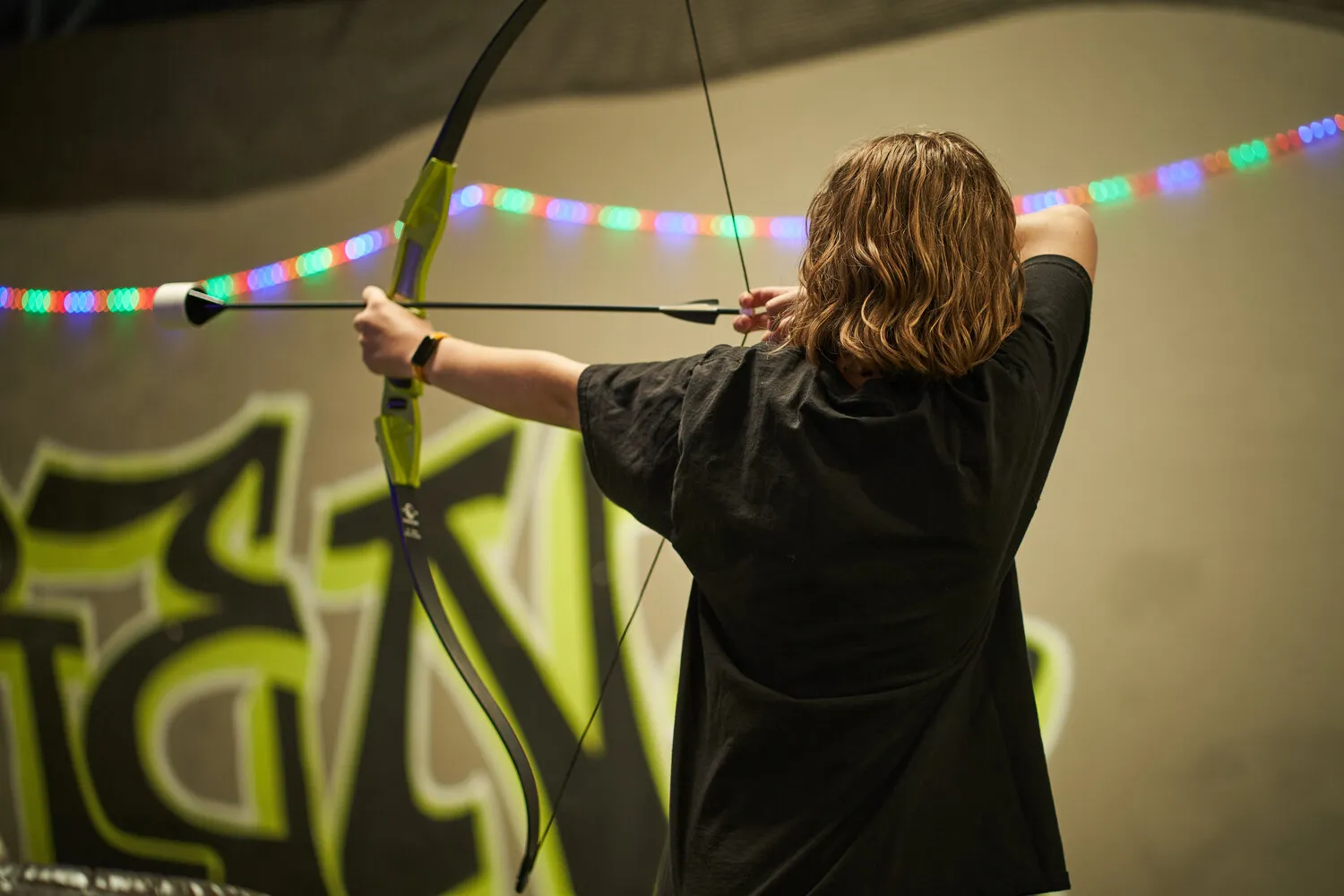The appeal of archery arrow tag lies in its unique combination of traditional archery and the fun, exhilarating atmosphere of tag games. Its rising popularity stems from the adrenaline rush it provides, attracting families, corporate teams, and young adults alike. Various exciting variations have emerged as the game evolves, each with its unique twist. This guide deeply explores these game variations, providing enthusiasts with a thorough understanding of maximizing their archery arrow tag experiences.
Key Takeaways
- Fast-paced variation enhances excitement through rapid rounds.
- Team-based variation fosters cooperation and communication skills.
- Individual challenges focus on personal skill development.
- Custom rules allow games to be tailored to specific events.
- Themed variations enhance immersion and overall enjoyment.
1. Fast-Paced Variation for Quick Rounds

The fast-paced variation of combat archery arrow tag focuses on adrenaline-fueled gameplay, allowing players to experience rapid-fire action. This variant incorporates shorter rounds, often lasting only 5–10 minutes, which keeps players on their toes and promotes continuous engagement. Limiting the duration allows participants to quickly strategize and execute their plays, making it an exhilarating experience. Research from team-building activities shows that fast-paced games can improve team dynamics and communication skills, making this variation perfect for corporate events.
Benefits of Shorter Matches
Shorter matches create an environment where players must remain hyper-focused and act swiftly, preventing the slow, drawn-out moments that sometimes occur in traditional tag games. The brevity of these rounds demands quick thinking, agility, and immediate strategy execution, resulting in an adrenaline-fueled experience that keeps both participants and spectators fully engaged. Players often find that the excitement builds continuously throughout short matches, making it easier to maintain peak performance without experiencing fatigue or loss of interest.
Strategy Adaptations for Speed
In a fast-paced variation, strategic planning significantly shifts from long-term control to short-term execution. Players prioritize aggressive offense, rapid movement, and instinctive reactions rather than carefully laid, slow-developing plans. Success in this format comes from adaptability—changing tactics on the fly, responding instantly to opponents’ moves, and capitalizing on fleeting opportunities. Because mistakes have immediate consequences in short rounds, players quickly learn to balance risk and caution with a heightened sense of urgency.
Ideal Settings for Rapid Play
The choice of venue plays a critical role in supporting fast-paced gameplay. Smaller arenas with minimal but cleverly placed obstacles allow for relentless action without excessive downtime. Indoor spaces with smooth flooring and clear sightlines encourage players to sprint, dodge, and fire rapidly, amplifying the thrill of constant engagement. Lighting and music can also enhance the energy, creating an intense, high-stakes atmosphere that mirrors professional sports settings and motivates players to perform their best.
2. Team-Based Variation for Cooperative Gameplay

The team-based variation encourages collaboration among players, fostering a strong sense of camaraderie. Teams are typically formed before the match, and strategies must be devised together, enhancing communication and teamwork. With designated roles within a team, like attackers, defenders, and strategists, this variation represents a compelling opportunity to build interpersonal relationships. Studies have shown that group activities improve cooperation, making it a prime option for group outings or team-building exercises.
Importance of Defined Roles
Clearly defined team roles bring structure and purpose to each match, transforming random gameplay into a coordinated, strategic effort. Players assigned to attack focus on eliminating opponents aggressively, while defenders guard critical zones and protect key players. Strategists analyze opponents’ behavior and suggest real-time adaptations. This division of labor ensures that everyone has a vital responsibility, fostering a greater sense of commitment, focus, and unity among team members.
Communication as the Key to Victory
Effective communication is the heartbeat of successful team-based archery arrow tag. Teams that consistently talk, signal, and update one another about enemy positions or changing strategies are likelier to outmaneuver less-coordinated opponents. Non-verbal communication, such as hand signals or eye contact, becomes equally important, especially in the heat of battle when vocal communication may be difficult. Learning to stay calm, clear, and concise under pressure is a skill that can be honed and carries benefits beyond the game arena.
Building Trust Among Team Members
Trust is an essential byproduct of the team-based variation, cultivated as players rely on each other to fulfill roles and carry out plans. When teammates know they can count on others to protect their backs or support their moves, they feel empowered to take calculated risks and play more confidently. Over time, this trust deepens, strengthening gameplay performance and interpersonal relationships, making archery arrow tag a powerful tool for building long-lasting bonds in corporate teams, youth groups, and friend circles.
3. Individual Challenge Variation to Test Skill

The individual challenge variation is designed to emphasize personal skills. In this format, players compete solo in various challenges that test accuracy, speed, and strategic thinking. Scoring can be based on targets hit and time taken, offering endless opportunities for players to challenge themselves and improve their skills. Individual formats often lead participants to develop self-competitive mindsets, potentially enhancing their performance in future group scenarios.
Solo Target Competitions
Solo target competitions allow players to measure their technical proficiency without the unpredictability of opposing teams. These games emphasize precision, forcing players to control their breathing, stance carefully, and shot timing under pressure. Hitting moving targets or achieving high scores within tight time limits demands focused practice, reinforcing core archery skills while maintaining the excitement of competition. Participants often enjoy tracking their improvement over time, motivating them to refine their form and consistency.
Time Trials for Speed and Agility
Time trials offer a high-energy platform to combine archery skills with physical agility, pushing players to complete tasks as quickly as possible. Navigating through obstacles, hitting targets rapidly, and maintaining accuracy under time constraints elevate the challenge to a new level. This tests a player’s raw athleticism and improves quick thinking and composure under stress, valuable attributes for both casual players looking to level up and serious enthusiasts aiming to sharpen competitive instincts.
Personal Growth Through Competition
Participating in individual challenges encourages players to cultivate resilience, self-discipline, and a growth mindset. Unlike team games, where outcomes depend on collective performance, individual variations place sole responsibility on the player and thus offer greater learning opportunities. Whether facing setbacks or celebrating victories, participants gain invaluable insights into their strengths and areas for improvement. Over time, this personal development can spill into everyday life, enhancing confidence, perseverance, and goal-setting abilities.
5. Custom Rule Variation for Tailored Events

The custom rule variation allows organizers to modify existing game rules or introduce new ones, making the archery arrow tag experience unique. Customization options include scoring systems, special abilities, and game objectives, enhancing engagement and excitement. Personalized rules cater to specific audiences, such as corporate teams seeking to promote specific values or families wanting to inject fun into their weekend, ensuring that the varying dynamics meet the interests of all participants.
Designing Specialized Objectives
Introducing customized objectives can transform a simple archery arrow tag game into a memorable and strategic adventure. Objectives such as defending a fortress, capturing hidden objects, or completing puzzle-based missions add multiple layers of challenge and engagement. These specialized tasks allow participants to experience the game in fresh, exciting ways, catering to specific themes or goals, promoting collaboration at a corporate retreat, or creating a magical, story-driven experience for a birthday party.
Incorporating Special Power-Ups
Special power-ups can dramatically enhance the gameplay, injecting creativity and unpredictability into every round. Elements like bonus arrows, temporary shields, or unique player abilities reward tactical thinking and risk-taking. Organizers can place power-ups in challenging locations, forcing teams or individuals to strategize when and how to retrieve them. Adding these elements transforms the game from straightforward combat into a multi-dimensional experience, heightening excitement and encouraging more diverse strategies.
Adapting Rules for Different Skill Levels
Adjusting rules based on players’ skill levels ensures inclusivity and balanced competition, making the event enjoyable for everyone involved. For beginners, simplified scoring systems or slower-paced games can lower barriers to entry and build confidence. For advanced players, introducing complex rules, faster gameplay, or advanced scoring criteria can keep the challenges stimulating. This adaptability makes archery arrow tag a versatile choice for family events, corporate outings, or community tournaments where participants may range widely in experience and ability.
6. Themed Variations to Enhance the Gameplay Experience

Themed variations of archery arrow tag incorporate narratives and costumes to bring the game to life. Themes can draw from popular culture, movies, or historical events. This creative twist encourages players to immerse themselves fully in the experience and enhances the overall enjoyment. For example, a “Hunger Games” theme could incorporate survival elements, while a “Dodgeball” theme might emphasize agility. Incorporating storytelling elements augments the excitement and promotes social interaction and bonding among players.
Popular Themes to Try
Choosing a theme adds excitement and immersion, elevating the archery arrow tag experience from a simple sport to a theatrical adventure. Popular themes like medieval battles, futuristic sci-fi wars, pirate treasure hunts, or survival-style games based on movies such as “The Hunger Games” offer something for every interest group. Each theme allows players to enter a new world for a few hours, enhancing emotional engagement and making the event more memorable and unique.
Costume and Prop Integration
Incorporating costumes and props transforms the atmosphere and encourages deeper player investment. Simple additions like medieval tunics, sci-fi armor, or pirate hats, combined with themed obstacle courses and dramatic lighting, can turn the arena into an entirely different environment. Props such as mock shields, treasure chests, or futuristic barriers add visual flair and open up new tactical options, inspiring players to think creatively and adding a sense of adventure to every encounter.
Storytelling to Deepen Engagement
Weaving a narrative throughout the event brings a sense of purpose and emotional depth to the gameplay. Instead of simply eliminating opponents, players might be tasked with rescuing a captured ally, retrieving a mystical artifact, or surviving a zombie outbreak. These story-driven missions create higher stakes, encouraging players to immerse themselves fully in the experience. Storytelling also fosters participants’ cooperation, ingenuity, and emotional connections, making themed variations a favorite for casual groups and serious event organizers.
Conclusion
The variations of the archery arrow tag game offer diverse experiences that cater to various audiences. Each format enhances distinct aspects of gameplay, from improving individual skills to fostering teamwork and strategic thinking. Embracing these variations can significantly enrich the enjoyment and effectiveness of team-building events and casual play. Participants of all ages will find excitement and engagement, making archery arrow tag a versatile activity suitable for any gathering.

